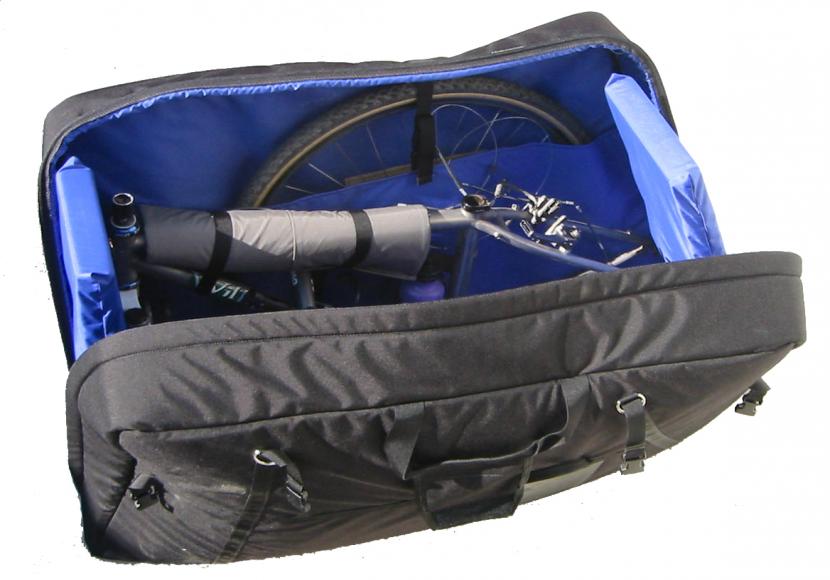July 6, 2013
1. Get a proper case
If you plan on traveling more than once with your mountain bike, or are doing multiple legs on your journey, invest in a proper case for your bike. Nothing sucks more than getting to your destination, opening up your cardboard bike box and finding a bent or broken dérailleur hanger or brake rotor, and then spending half a day looking for bike shops to fix the problem. See the next section (A guide to protecting your mountain bike) for more information on the various types of bike protection.
2. Clean your bike before you go
Some countries (like New Zealand, for instance) are really strict about foreign dirt coming into the country; your dirt-caked tires might look really cool, but they could also result in your bike being impounded. Do your research, and if you need to, give your bike a proper cleaning and washing before packing it up for travel. Plus it’s a lot nicer pulling a clean bike out of your case and caking it with fresh local dirt!
3. Don’t just use your bike bag for your bike
All airlines have a maximum weight allowance for your main checked baggage, but you can often get around this by transferring clothes and other gear from your luggage to your bike case (you usually pay a flat rate to bring a bike on the plane, with no weight restriction). If you’ve followed suggestion #2, then you can kill two birds with one stone by wrapping your bike clothes (jerseys, shorts, armour, etc…) around your bike frame to further protect it.
4. Bring lots of riding clothes
Let’s face it, mountain bike gear gets dirty – and really stinky – fast. You may think you can get more than 1 day out of a jersey, but trust me – after you’ve put a hard day of riding into a jersey or shorts, you’re really not going to want to put them on again the next morning. And you probably don’t want to spend a big chunk of our vacation sitting at laundromats, so bring at least 3 or 4 jerseys and shorts if you have them. Ditto with socks.
5. Shipping vs. Flying vs. Renting
If you’re flying to your destination then you have three options for having a bike at your destination: ship it via mail/courier or bring it with you on the plane or rent a bike.
Shipping
If you’re staying within your continent (e.g. North America, or Europe) then shipping your bike may make sense: you don’t have to lug it around with you, courier companies are usually more careful with your bike than airline baggage handlers, and you can purchase insurance easily. Here are a few shipping options:
- FedEx (They will insure your bike case.)
- UPS (According to Adventure Cycling Association, UPS costs more and takes longer than FedEx. They will not insure your bike case.)
- Bikeflights (Prides itself on being the “easiest and cheapest” way to ship a bike.
Flying
If you’re flying away from your home continent, then it’s usually prohibitively expensive to ship your bike (for example, shipping a bike from our office in Toronto to Lima, Peru is about $600 CAD) and it makes more sense to bring it with you on the plane. Most airlines charge an extra fee for transporting a bike, generally anywhere from $50-$250 each way. Although it’s a bit of a hassle to pack up your bike and lug it with you to the airport, it’s usually not as much hassle as you might think.
Renting
A final option is to rent a mountain bike at your destination. While we generally recommend our Riders – and all mountain bike travelers — bring their own bikes with them (you’ll usually ride better on a familiar bike, unless your familiar bike is a piece of crap), sometimes it’s just more convenient to rent, for example if you’re planning on traveling on after your mountain bike trip and don’t want the hassle of lugging your bike around or storing your bike. A few recommendations re: rental bikes:
- Plan ahead: in high season many shops are slammed and may not have availability at the last minute, so book your bike well in advance
- Ask for exact details on brand, model and year of their fleet.
- Ask how often they maintain their fleet: are they inspected and maintained after each ride, or on a periodic basis?
- Ask about their damage policy: for instance, whose responsibility is it if the dérailleur hits a rock and the hanger snaps off? Or whose responsibility is it if the front fork blows out and leaks oil all over the place?
- Sizing is super-important: a medium Specialized doesn’t fit the same as a medium Santa Cruz. If you’re interested in a rental, find out the model and then find a local shop in your area that sells or rents the same bike, and go to the store and try out bikes to find your size. At Sacred Rides we’ve partnered with great local bike shops and rental shops in all of our destinations to ensure that we have high-quality mountain bike rentals for our Riders. Whether you’re traveling with us or on your own, feel free to drop us a line to ask about rental options in our destinations.
- Check your airline’s baggage policies. It pays to read the fine print about baggage policies: some airlines even go so far as to prohibit bikes on planes. Read the fine print about weight restrictions, bike fees, etc.. before you decide to book that flight.

